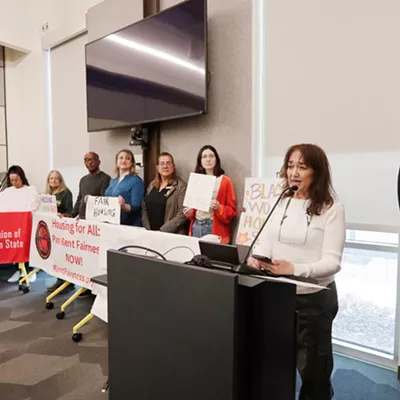
On Monday, the Seattle Times published a story on how school districts in Washington serve as the last line of defense for homeless students — a population that's been climbing recently.
The story briefly mentions that rural parts of Spokane County have seen the student homeless population double in the last five years. Read quickly, and you might misinterpret that as saying student homelessness in all of Spokane County has doubled — a mistake the Inlander made on Monday when linking to the article. And KREM, too, interpreted it that way, publishing a story on how student homelessness in Spokane County is "on the rise" and saying it's doubled since 2012.
The actual data, though, tells a different story. In fact, student homelessness in 2016-17 — the most recent year data from the state is available — shows 3,126 homeless students in Spokane County. That's roughly the same as the number in
So student homelessness in Spokane County is not really "on the rise." And it certainly hasn't doubled. (Keep in mind, schools count a student as homeless if they don't have a stable living situation but might be "doubled up," or living with friends or relatives or otherwise have a roof over their head.)
What the data does show is a rise in student homelessness towards the edges of the county. Here's a graph of the homeless count in each district in Spokane County, in 2012-13, and then in 2016-17:
Local agencies are well aware of the problem
Ryan Oelrich is the executive director of Priority Spokane, which has made stabilizing homeless families its focus in recent years. Its pilot project of strategically placing community health workers in schools — including Spokane Public Schools and Deer Park School District — has had "promising results," Oelrich says. Since the 2016-17 school year, the project has housed 166 students, according to data provided by Priority Spokane. Spokane Public Schools saw a major dip in the overall student homeless population, dropping by nearly 500 since 2015-16. Spokane, too, is leading the way in getting homeless students to graduate.
But Mead, Deer Park, East Valley
"We're looking at additional funding and resources to expand to the Valley," he says. "That's definitely at the top of the list."
East Valley has seen a 458 percent spike in student homelessness since 2012. West Valley saw a 149 percent increase. For both districts, the biggest spike came in the 2013-14 school year — though that abrupt change may be partly attributed to better reporting from schools.
Still, the question remains: Why is there an increase in student homelessness on the outskirts of Spokane County?
Leslie Camden-Goold, homeless student liaison for Central Valley School District, says rising rent has something to do with it.
"Last year, I had families calling me and telling me rents were increasing by $200-$400 a month, and there was no way they could afford it," she says. "Essentially they were becoming homeless because of rent."
Oelrich wonders if families who cannot find affordable housing in the city are being forced to other parts of the county, then losing housing there. But that's "a hypothesis at this point," Oelrich says.
Oelrich says local agencies have studied the data, and they know families in more rural parts of the county are struggling. Exactly why that's happening, however, remains unclear.
"It's a complicated question," Oelrich says.





















